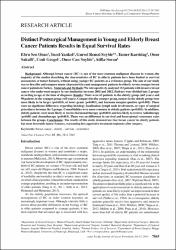| dc.contributor.author | Şen Oran, Ebru | |
| dc.contributor.author | Yankol, Yücel | |
| dc.contributor.author | Soybir, Gürsel Remzi | |
| dc.contributor.author | Karşıdağ, Tamer | |
| dc.contributor.author | Sakallı, Onur | |
| dc.contributor.author | Geçgel, Ümit | |
| dc.contributor.author | Soran, Atilla | |
| dc.date.accessioned | 2022-05-11T14:34:54Z | |
| dc.date.available | 2022-05-11T14:34:54Z | |
| dc.date.issued | 2014 | |
| dc.identifier.issn | 1513-7368 | |
| dc.identifier.uri | https://doi.org/10.7314/APJCP.2014.15.18.7843 | |
| dc.identifier.uri | https://hdl.handle.net/20.500.11776/8133 | |
| dc.description.abstract | Background: Although breast cancer (BC) is one of the most common malignant diseases in women, the majority of the studies describing the characteristics of BC in elderly patients have been limited to survival assessments or tumor features, without using younger BC patients as a reference group. The aim of our study was to describe and compare tumor characteristics and management patterns in elderly versus younger breast cancer patients in Turkey. Materials and Methods: We retrospectively analyzed 152 patients with invasive breast cancer who underwent surgery in our institution between 2002 and 2012. Patients were divided into 2 groups according to age at the time of diagnosis. Results: There were 62 patients in the elderly group (>= 65 years) and 90 patients in the younger group (<65 years). Compared to the younger group, tumors in the elderly group were more likely to be larger (p=0.018), of lower grade (p=0.005), and hormone receptor-positive (p>0.001). There were no significant differences regarding histology, localization, lymph node involvement, or types of surgical procedures between the 2 groups. Comorbidities were more common in elderly patients (p<0.001). In addition, elderly patients were more likely to receive hormonal therapy (p<0.001) and less likely to receive radiotherapy (p=0.08) and chemotherapy (p=0.003). There was no difference in survival and locoregional recurrence rates between the groups. Conclusions: The results of this study demonstrate that breast cancer in elderly patients has more favorable tumor features, warranting less aggressive treatment regimens after surgery. | en_US |
| dc.language.iso | eng | en_US |
| dc.publisher | Asian Pacific Organization Cancer Prevention | en_US |
| dc.identifier.doi | 10.7314/APJCP.2014.15.18.7843 | |
| dc.rights | info:eu-repo/semantics/openAccess | en_US |
| dc.subject | Breast cancer | en_US |
| dc.subject | elderly | en_US |
| dc.subject | survival | en_US |
| dc.subject | recurrence | en_US |
| dc.subject | Older Women | en_US |
| dc.subject | Surgical-Management | en_US |
| dc.subject | Decision-Making | en_US |
| dc.subject | Age | en_US |
| dc.subject | Features | en_US |
| dc.subject | Surgery | en_US |
| dc.subject | Information | en_US |
| dc.subject | Malaysia | en_US |
| dc.subject | Therapy | en_US |
| dc.title | Distinct Postsurgical Management in Young and Elderly Breast Cancer Patients Results in Equal Survival Rates | en_US |
| dc.type | article | en_US |
| dc.relation.ispartof | Asian Pacific Journal of Cancer Prevention | en_US |
| dc.department | Fakülteler, Tıp Fakültesi, Cerrahi Tıp Bilimleri Bölümü, Genel Cerrahi Ana Bilim Dalı | en_US |
| dc.identifier.volume | 15 | en_US |
| dc.identifier.issue | 18 | en_US |
| dc.identifier.startpage | 7843 | en_US |
| dc.identifier.endpage | 7847 | en_US |
| dc.institutionauthor | Soybir, Gürsel Remzi | |
| dc.institutionauthor | Sakallı, Onur | |
| dc.institutionauthor | Geçgel, Ümit | |
| dc.relation.publicationcategory | Makale - Uluslararası Hakemli Dergi - Kurum Öğretim Elemanı | en_US |
| dc.authorscopusid | 56235741300 | |
| dc.authorscopusid | 6505675113 | |
| dc.authorscopusid | 35608451600 | |
| dc.authorscopusid | 6505953119 | |
| dc.authorscopusid | 56387511700 | |
| dc.authorscopusid | 6506175498 | |
| dc.authorscopusid | 55364150900 | |
| dc.authorwosid | Şen, Ebru/ABB-6373-2021 | |
| dc.identifier.wos | WOS:000343833600058 | en_US |
| dc.identifier.scopus | 2-s2.0-84908032472 | en_US |
| dc.identifier.pmid | 25292075 | en_US |



















